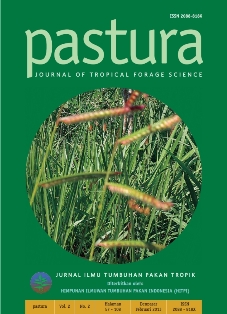PENINGKATAN PRODUKSI RUMPUT GAJAH (Pennisetum purpureum) DAN RUMPUT SETARIA (Setaria splendida Stapf) MELALUI PEMUPUKAN BIOURIN
Abstract
Research aimed to increase forage production through improved soil fertility by using biourine organic fertilizer. Grass differences as the main plot consisting of elephant grass (Pennisetum purpureum) or R1 and Setaria (Setaria splendida Stapf) or R2. Biourin fertilization as sub plot ie without cattle biourine fertilizer (B0), 25 000 lt/ha cattle biourin fertilizer (B1), 50 000 lt/ha cattle biourin fertilizer (B2) and 75 000 lt/ha cattle biourine fertilizer (B3). No significant interaction on all the variables observed between grass differences with biourine fertilization level. The study concluded elephant grass production was higher than those setaria grass. Biourine Fertilization with a dose 75.000 l/ha produced grass production was higher than those 50 000 l/ha, 25,000 l/ ha and without fertilization.Downloads
Download data is not yet available.
How to Cite
NURIYASA, I M. et al.
PENINGKATAN PRODUKSI RUMPUT GAJAH (Pennisetum purpureum) DAN RUMPUT SETARIA (Setaria splendida Stapf) MELALUI PEMUPUKAN BIOURIN.
Pastura, [S.l.], v. 2, n. 2, june 2014.
ISSN 2549-8444.
Available at: <https://ojs.unud.ac.id/index.php/pastura/article/view/9029>. Date accessed: 03 jan. 2026.
doi: https://doi.org/10.24843/Pastura.2013.v02.i02.p09.
Issue
Section
Articles
Keywords
grass differences, biourin, growth, poduction.





